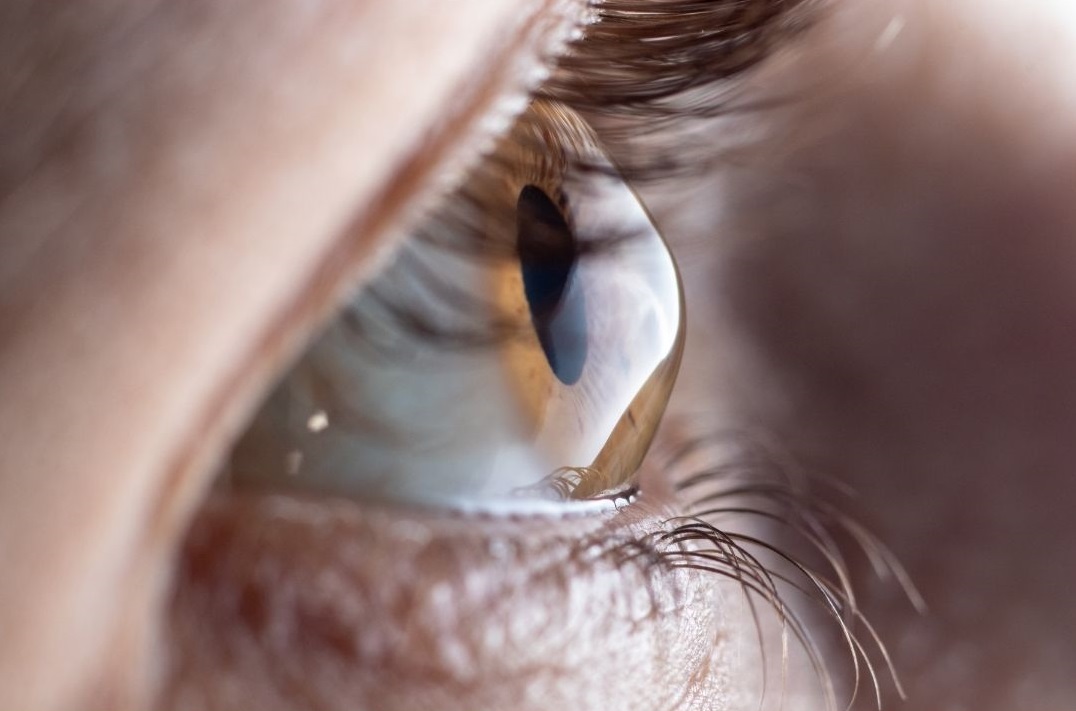Keratoconus is a chronic degenerative disease of the cornea. It is not yet known exactly what is causing it. However, it is likely caused by a gene that stretches corneal collagen fibers. This causes the otherwise domed shape of the cornea, which resembles a sphere, to acquire a conical asymmetrical arch. In addition to bulging the cornea outwards into the shape of a cone, its thickness also decreases.
The cornea forms the first mechanical as well as chemical barrier between the outside world and the inside of the eye. It is the most stressed part of the eye that has to face external influences and is exposed to the risk of injury. It has a number of nerve endings that are sensitive to touch, temperature changes or chemical properties. It is protected by a tear film, which often dries the cornea and cleans it.
How does keratoconus arise?
Among the first and most common signs appears blurred visual perception. The cone-shaped cornea causes blurred vision and can cause sensitivity to light and reflections. Vision gradually deteriorates with keratoconus, so prevention is important. Especially if you have a family member with this diagnosis, as there is a hereditary predisposition. Stress or lifestyle can contribute to its formation. Another factor is, for example, an excessive sunlight. However, this is not specific for Slovakia. For that reason the proportion of diseases in our country is “only” 1 : 2 000. Most patients are accompanied with other symptoms. These are e.g. frequent allergies, atopic eczema, hay fever, acne or certain types of skin diseases, even diseases such as Down’s or Turner’s syndrome. Patients usually rub their upper eyelids, making the condition worse.
 Keratoconus usually affects both eyes, although it often affects one eye more than the other. Some scientists think they occur from birth but manifests only later. It usually begins to appear in people between the age of 10 and 25. Therefore, it is necessary to listen to the complaints of even small children for poorer vision, they may e.g. mess similar looking letters or numbers. The fact that it is not just astigmatism (reduced visual acuity, impaired perception of details, distorted image) suggests that the diopter is constantly changing in the keratoconus eye. Then a special professional eye examination is needed, where visual acuity, eyelids, conjunctiva and tear film are examined.
Keratoconus usually affects both eyes, although it often affects one eye more than the other. Some scientists think they occur from birth but manifests only later. It usually begins to appear in people between the age of 10 and 25. Therefore, it is necessary to listen to the complaints of even small children for poorer vision, they may e.g. mess similar looking letters or numbers. The fact that it is not just astigmatism (reduced visual acuity, impaired perception of details, distorted image) suggests that the diopter is constantly changing in the keratoconus eye. Then a special professional eye examination is needed, where visual acuity, eyelids, conjunctiva and tear film are examined.
How is keratoconus treated?
This visual impairment is most often addressed by solid or hard contact lenses, which partially balance the shape of the keratoconus cornea. Unlike classic soft lenses, they are tailor-made. And despite the small diameter (only around 9.6 mm, while the diameter of the cornea is 12 mm), they ensure a high quality of vision. The exchange of tears is very good under them, which increases their service life with up to 1-2 years. It also reduces their maintenance requirements. Hard contact lenses can be worn daily, even for more than 10 hours, and can be used for any irregular shape of the cornea – after corneal injuries, and alike.
The method of solving this disease is known as crosslinking, which strengthens the cornea with new riboflavin and subsequent UV radiation. It is still used in the 1st stage of the disease. In the 2nd, 3rd and sometimes 4th, the implantation of special corneal rings made of hard plastic is performed to compress and stabilize the cornea. Stage 4 already requires a corneal transplant from a donor, but patients still need glasses or contact lenses.
Although it still cannot be completely cured, early diagnosis can be very well matched with the help of state-of-the-art methods. The hard lens acts on the cornea like a corset and prevents the disease from developing further. In Lens Optik we specialize precisely in hard lenses and keratoconus treatment. We are being helped by a slit lamp, autorefractokeratometer and to precisely set the parameters of lenses we use a very special device – keratograph. In addition to hard contact lenses from a Swiss manufacturer, we can also offer hybrid contact lenses. In our Lens Center, we will guide you to apply a hard contact lens and teach you how to take care of it.
The article was written in collaboration with Angelika de Rossi.
An additional video can be found at this link.



